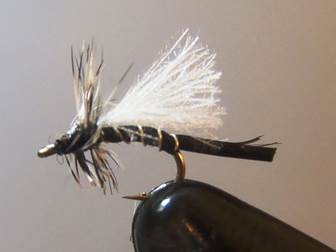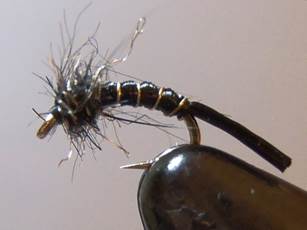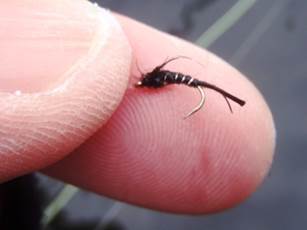FOOD SOURCES ON SPRING CREEKS (part 4)
| Sysadmin Note |
|---|
| Part 3 can be found here |
Chapter 4: Midge Emerger (ascending pupa)
Midge (Diptera) undergo a complete metamorphosis like caddis. Hence the term emerger, which we often use for mayfly hatch stage, may not be appropriate in the scientific and taxonomical senses. However, for spring-creek anglers the term is commonly used. We mean:
- Pupae that are ascending to and reaching almost the water surface
- Midge adults that are leaving (or struggling to leave) their pupal shucks.
Trout will key on what's available to them and the hatch stage in which insects are most vulnerable (the easiest stage for trout to capture them). Midge hatches and fishing during it may not be for everyone. I think it's mostly because flies are small. Those are hard to see when fishing on the surface. Also anglers are forced to use finer tippets, which translate to careful hook-sets and skillful fish-fighting. Additionally the trout will care about size, shape, and color of even these tiny creatures. If we want to catch them with our flies we have to play by their rules.


These stomach samples were taken from trout that were "rising".
Seasonal Importance:
Midges are available for trout all through the year, and more specifically, I like to divide midge availability into two phases.
1. In a yearly cycle, midge hatches will cause trout rises in March (the end of March provides more predictable hatches). Then, after the fall Baetis hatches are over sometime in November, midge hatches can cause trout rises again in November and December (and January and February, if you are lucky). An important note is these are the periods when other insects are not active but only midges. Midges will hatch in the middle of summer and in the fall too.
2. So when midges hatch during the period when other insects are active, we have to figure out what trout are keying on. Often midges are causing rises before hatches of other prime insects occur. Then, once prime hatches are over midges still can bring trout up to the surface. Now we are talking about an hourly cycle of the day. The bottom-line is: be prepared for midge hatches any time at spring creeks!
Midge APE

- Hook: Emerger #20, 22, 24
- Thread: Veevus 16/0 black
- Ribbing: Fine silver wire
- Shuck & Abdomen: Life Flex, black. Abdomen is NOT wrapped but just secured above thread under-body with the silver wire.
- Wing: White CDC
- Hackle: Grizzly, trimmed flat at the bottom
Note: APE stands for "Adult, Pupa, Emerger". Dress ONLY CDC wing with CDC oil floatant.
Pupaerger


- Hook:Emerger #20, 22, 24
*I also use scud hooks and light-wire scud hooks in the same sizes to penetrate the surface a bit quicker than emerger hooks do. Besides scud hooks are stronger than emerger hooks. - Thread: Veevus 16/0 black
- Ribbing: Fine silver wire
- Shuck & Abdomen: Life Flex, black. Abdomen is wrapped around the shank.
- Thorax: Shaggy, with a bit of sparkle, black dubbing
Note: This pattern became the massive success instantly. I have caught many trout that were selectively feeding on ascending pupa/emerger (hence the name). Right photo attests the bruise caused by large individuals (and that's why scud hooks can be used oftentimes).
How to Fish:
I almost always fish with a dry-fly and subsurface fly combination. Apparently those two above make the perfect combination. The top fly can be taken by itself and then it serves as an indicator for the emerger or ascending pupa patterns.
Midge Mania:
Whether on spring creeks or big rivers like the Yellowstone and Madison rivers, midge hatches provide some of the finest fishing experiences. Apparently I'm one of those "aficionados". In my case, I try to fish every month of year so I usually experience the first and the last rises of the year with midges. On those days, any trout caught on my dry-flies are pleasures to me. Then when I encounter groups of trout feeding "exclusively" on midges and "selectively" on a certain hatch stage, my fishing sense is in the stage beyond description.

One of the most challenging and technical midge situations on DePuy Spring Creek. Once hooked, the fight was the toughest and the most careful one with a long leader which ended with 6X tippet. Fly was Pupaerger illustrated above.
Satoshi Yamamoto, http://leftyangler.blogspot.com, is a guide and a professional fly-tyer in Livingston, MT.
| Sysadmin Note |
|---|
| Part 5 can be found here |
